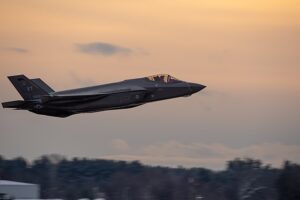David Fowler

The war in Ukraine illustrates that defense is indeed the stronger form of war. The inability of the Russian Aerospace Forces (VKS) to overcome Ukrainian air defences and achieve air superiority stymied the chance of a swift and decisive Russian victory. Instead, the war has stagnated into a war of attrition. At a theoretical level, Ukraine’s ability to effect a strategy of air denial against a technologically and numerically superior air force challenges the credibility of military strategies premised on attaining and maintaining air superiority as the cornerstone of defence and deterrence. DAVID FOWLER analyses the success of Ukrainian defence and how small states can adapt similar strategies in their defence policies.
COMMENTARY
The war between Russia and Ukraine illustrates the truth behind Clausewitz’s aphorism that the defensive form of warfare is intrinsically stronger than the offensive. The moral strength that the Ukrainians have gained from the knowledge they are defending their country appears, for now, resolutely up to the task of offsetting Russian numerical and technological superiority. The strength of the Ukrainian defence, however, depends on more than just the moral advantages of fighting on home turf. The emergence of new defensive technologies has played a critical part in denying Russia the swift and decisive victory that Moscow had perhaps envisioned. The Ukrainian military’s successful denial of effective air superiority to the Russian Aerospace Forces (VKS) illustrates the relative strength of defence on the modern battlefield.
Explaining Russian Failings
Although criticisms of the VKS being missing in action in the early days of the war now seem overstated, it does appear that they were quite unable to force entry deeper into Ukraine and deliver anything close to a decisive air campaign of shock-and-awe. This was not, however, for want of trying. Having deployed some 350 modern fighter aircraft for the operation, the VKS certainly showed up in numbers and was relatively successful in destroying fixed Ukrainian air defence radars and missile systems in the initial phases of the conflict. But Ukraine’s measured employment of its own fighter aircraft, along with its innovative use of mobile medium- and long-range surface-to-air missile systems, has effectively contested and denied the VKS the freedom to operate manned aircraft over Ukrainian airspace very much beyond the frontlines in the east and south.
Flawed operational doctrine and inadequate training in mounting complex air operations likely contributed to the VKS’s initial underperformance. Experience and operational adaptation will, however, mitigate these failings, leaving only the continued operation of Ukraine’s air defences to deny Russia air superiority. Only continued denial of the airspace will prevent the VKS from employing its sizeable manned fighter-bomber fleet to pound strategic targets in Ukrainian cities, just as it did in Syria. For now, however, Russian strategic air power in Ukraine is limited to costly cruise and ballistic missile barrages with limited effectiveness – air power remains an indecisive instrument of Russian military power.
Air Denial as a Viable Strategic Option?
This trend towards the technological dominance of defence raises several theoretical questions. These are pertinent not only for the ongoing conflict in Ukraine, but also more generally for military strategies and defence policies premised on gaining air superiority as a prerequisite of national defence and which underwrite the credibility of conventional deterrence.
Observing Ukrainian successes in defending their airspace, any hypothetical state fearing an expansionist neighbour might cede its own ability to achieve air superiority and instead rely on air denial as a cost-effective means of raising risk and uncertainty to deter any potential aggressor. Such a strategy of denial is frequently cited as the appropriate strategic choice for Taiwan, and the same might be true for other small states like Singapore, looking to make cost-effective procurement choices to sustain a credible deterrent capability as the cornerstone of its defence policy. Such a strategy of air denial would, however, necessitate a shift in procurement priorities away from limited fleets of expensive and exquisite air platforms normally associated with achieving air superiority, to large numbers of more cost-effective mobile medium- and long-range air defences.
An air denial strategy is, however, a nuanced strategic calculation with its own costs and risks. For example, the Ukrainian ability to stiff-arm any attempt at Russian shock-and-awe bought Kyiv time, but it did so only by trading space. This allowed Ukraine to rally its forces and garner military support from the US and other states, eventually generating capacity and momentum to launch its own counteroffensive. Defense may be the stronger form of warfare, but it is not a means to victory in itself. A state will rarely win a war through defence alone and must instead turn the relative strength of home court advantage towards the offensive to win and achieve some form of status quo ante. Small states without the luxury of strategic depth cannot generate the time that reactive strategies of denial require to survive and win.
Neither, necessarily, have small states outside of established military alliances like NATO access to large stockpiles of defensive munitions that strategies of denial require. The war in Ukraine illustrates that defensive wars are structurally inclined towards attrition. Just as barbed wire and trench warfare stymied the spirit of the offensive in the First World War, the dominance of defense has dragged the war in Ukraine into relative stalemate where any theory of victory becomes dependent on the ability to resupply men and materiel rather than on the decisive use of exquisite technology. Small states reliant on relatively small munitions stockpiles without a significant sovereign military-industrial capacity and with uncertain access to third party military assistance should be wary of entering into protracted conflict by choice. Air denial does not secure swift and decisive victory.
From Defence to Offence – Considerations and Challenges
The logical conclusion is that small states should not rely solely on defensive strategies of denial, but must also look to retain offensive options, not for any aggressive ambitions themselves, but to project the credibility of deterrence through either punishment or denial. Either option is likely to require some degree of air superiority – that capability to force entry and hold a potential aggressor’s centres of military strength and political value at risk.
This logic, however, takes us back to the issue of the dominance of air denial, only this time we must consider the consequences where any hypothetical adversary obtains the means to deny entry into its airspace. As United States Air Force Lieutenant General S. Clinton Hinote framed the issue, “the barriers to entry for denial, for denying the use of airspace, are much lower these days than the barrier to entry for extending control and keeping control of the airspace.” He is right: exports of advanced air defence systems like the Russian S-300 and its variants to countries, including Iran and Syria, illustrate the ubiquity of such systems. Any small state’s approach to contesting the air must take the future proliferation of these systems into mind – air superiority should never be assumed based on current offensive-defensive calculations.
Reflexively, most militaries look to next-generation stealth aircraft or long-range precision strike (air and/or ground launched) as a means overcoming a defender’s denial of air superiority. Exquisite technology is, however, no panacea.
The example of Ukraine shows that long-range munitions are just as vulnerable to air defences as manned aircraft are, and are therefore no guarantor of effective precision strike, particularly against mobile or time-sensitive targets. While fifth-generation stealth aircraft like the F-35 procured by Singapore may be capable of delivering credible deterrent threats, overbearing costs may limit fleet sizes to the extent these platforms are unable to saturate modern layered air defence systems to overwhelm them by stealth alone. Tellingly, Russia has chosen to cosset its own limited numbers of fifth-generation stealth fighters (the Su-57 Felon) far from Ukrainian airspace, likely fearing the reputational and strategic consequences of having one shot down. One questions the credibility of the Felon to command air superiority and operate in the modern battlespace with relative impunity, i.e., the sine qua non of fifth-generation stealth.
Ramifications
Reacting to the dominance of modern air defence systems in Ukraine, a number of Western air forces are considering not only the need for stealth aircraft in contesting airspace, but also the need to develop new suppression and destruction of enemy air defence capabilities (SEAD/DEAD) for these aircraft to employ.Militaries are not only looking to invest in next-generation stealth aircraft, such as the F-35, but also to the development of new suppression and destruction of enemy air defence capabilities (SEAD/DEAD) to achieve air superiority in an increasingly contested air environment. Image from Wikimedia Commons.
Many modern air forces had assumed that stealth technology rendered SEAD/DEAD capabilities (i.e., capabilities to actively target enemy air defences) somewhat redundant; however, the Russian inability to penetrate an advanced air defence system, along with the apparent success of US-supplied anti-radiation missiles (ARMs, used to target air defence radars) retrofitted to Ukrainian MiG-29 fighters, has disabused doubters of the assumption that SEAD/DEAD was dead.
Years of underinvestment in these capabilities is now being addressed by several air forces like the French Air Force. States that are busy filling the order sheet for F-35 production should also consider just how that platform will find, suppress and kill modern air defence systems. Kinetic capabilities, electronic attack capabilities like MBDA’s SPEAR-EW and the ability to saturate air defences using air launched swarming technology like the Perdix system will form the backbone of the 21st century SEAD/DEAD mission required to achieve air superiority in an increasingly contested air environment.
Expensive though these systems may be, the dominance of emerging defensive technologies demands a more holistic approach to air superiority and maintaining a credible offence-defence balance.


No comments:
Post a Comment